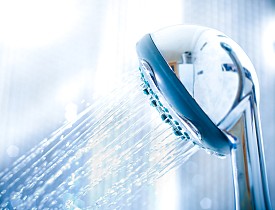Green Retrofitting
 There are plenty of ways to save energy, water and resources with bathroom upgrades. You can cut your toilet's water usage in half or even to zero; make the lighting, ventilation and showerhead more efficient; or add recycled materials to a remodel.
There are plenty of ways to save energy, water and resources with bathroom upgrades. You can cut your toilet's water usage in half or even to zero; make the lighting, ventilation and showerhead more efficient; or add recycled materials to a remodel.
Dual-Flush Toilet Switch
Toilets are becoming more water-efficient, but they still drain an average of 3.5 gallons per flush. There are several ways to reduce your toilet's water footprint. A cheap option is the Perfect Flush adapter, which turns a standard toilet into a dual-flush toilet. A half flush will clear out lighter loads, significantly reducing water usage. The full tank option is still available for larger loads. The adapters start at about $100. Several types of dual-flush toilets also are available if you need a new toilet.
Composting Toilets
A more complicated option is the composting toilet, which uses bacteria to decompose your toilet solids. No need to flush. Just sprinkle in the compost mix. The toilets use no water, and convert excrement into nutrient-rich humus, which is like soil. Composting toilets require more maintenance than flush toilets and may take some getting used to, particularly for the squeamish. You can see (but usually not smell) some of the waste, and the humus tray needs to be cleared regularly.
Electric Incinerating Toilet
Another toilet that uses no water is the electric incinerating toilet, which uses electric heat to burn waste into a small pile of disposable ash. Insert a liner into the toilet bowl, do your business and push a button to drop the full liner into an incinerator. A home model costs $1,700, so it's not a cheap option. Also, the unused water is replaced by some electric usage, but it still may be more environmentally responsible.
Low-Flow Showerhead
A simpler way to save water is to install a low-flow showerhead. Most models easily slip onto a standard shower arm to replace an existing showerhead. To take the water savings one step further, consider a Showerstart showerhead. After turning on the water, the showerhead won't start flowing until the temperature reaches 95 degrees. When the water is warm, the showerhead starts to trickle. Pull a cord and a full, hot shower starts flowing. The corded showerhead comes in various sizes and styles, including several low-flow options.
LED Lighting
Design experts say light-emitting diodes (LEDs) are the future of home lighting. They are bright, versatile and use less energy than compact fluorescent light bulbs. They are commonly used in traffic lights and electronic highway signs, but Eye LED and other leading companies are developing new colors and softer light for home usage. LED home lighting is still quite expensive, but energy-conscious homeowners can start with a couple of bathroom fixtures or even a faucet light. For less than $20, you can replace a bathroom faucet or showerhead with a model surrounded by an LED that switches from green to red depending on the temperature of the water.
Efficient Bathroom Fans
Many older homes do not have bathroom fans, but fans are important for indoor air quality and to prevent moisture buildup. If you need a new bathroom fan, consider energy efficiency. WhisperGreen fans are significantly more efficient than the EnergyStar standard and are comparable in cost to other models. They are very quiet and have handy options including built-in lights and motion sensors for automatic operation.
Solatube
Bathrooms often are the darkest rooms in the house, and we are forced to waste energy every time we turn on a bathroom light during the day. Instead, install a solar tube skylight for free natural daytime lighting that is cheaper, easier to install and more hassle-free than traditional skylights. Tubular skylights have a solar collector in the roof and flexible tubing down to the bathroom ceiling or any other location that needs extra light. The lights may also be eligible for tax credits.
Recycled Glass Tile
Green bathroom retrofits aren't just about energy. There are also several ways to reuse materials, including recycled glass tiles. Sandhill Industries makes only 100-percent recycled tiles, but other larger companies have recycled tile options. The tiles reuse resources and take less energy than ceramic tile to manufacture. Sandhill makes a wide variety of colors, sizes and shapes that start at $28 per square foot.
Recycled Copper Sinks
Ecobre makes recycled copper sinks and fittings. Starting at about $500, they are more expensive than porcelain sinks, but they make a unique and stylish statement. Other recycled sinks and tubs are also available, including antique clawfoot tubs or discarded sinks that may just need a little scrubbing. Check used building supply stores and antique malls.
Green Bathroom Vanities
Waterfall bathroom vanities are eco-conscious from the tap to the bottom drawer. The company uses formaldehyde-free wood from sustainable forests, Low VOC paints and lacquers, and recycled quartz countertops. Again, other options are available for vanities including creative DIY projects such as converting a small old-fashioned desk into a bathroom vanity.
Looking for a Pro? Call us (866) 441-6648

Plumbing Average Costs
Plumbers Experiences

The Right Landscaper Can Change A Yard From Terrible To Terrific

Fast Professional Tree Service For My Crabapple And Persimmon



